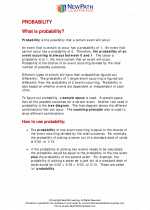Interval Estimation
Interval estimation is a statistical method used to estimate an unknown population parameter (such as a mean or proportion) based on sample data. It provides a range of values within which the true parameter is likely to lie, along with a level of confidence.
Confidence Interval
A confidence interval is a range of values calculated from sample data that is likely to contain the true population parameter. It is expressed as an interval with a specified level of confidence, often denoted by a percentage (e.g., 95% confidence interval).
Steps for Calculating Confidence Interval
- Collect a random sample from the population.
- Calculate the sample statistic (mean, proportion, etc.) of interest.
- Determine the appropriate confidence level and find the corresponding z-score or t-score.
- Use the sample statistic, standard deviation (if known), sample size, and the z-score or t-score to calculate the confidence interval.
- Interpret the confidence interval in the context of the problem.
Example
Suppose we want to estimate the average height of students in a school. We take a random sample of 100 students and calculate the sample mean height to be 65 inches. Assuming a standard deviation of 3 inches, we want to find a 95% confidence interval for the true average height of all students in the school.
Using the z-table, we find the z-score for a 95% confidence level is 1.96. The margin of error is then calculated as 1.96 * (3 / √100) = 0.588.
Therefore, the 95% confidence interval for the true average height is 65 ± 0.588, or (64.412, 65.588) inches.
Study Guide
When studying interval estimation, it's important to understand the following key concepts:
- Sample and population
- Sample statistic and population parameter
- Confidence level and confidence interval
- Z-score and t-score
- Margin of error
Practice calculating confidence intervals for means and proportions using different confidence levels and sample sizes. Understand how changes in sample size and confidence level affect the width of the confidence interval.
Additionally, familiarize yourself with the interpretation of confidence intervals and how they provide a measure of precision for estimating population parameters.
Remember to also review the assumptions and conditions necessary for interval estimation, such as random sampling, normality, and independence.
By mastering interval estimation, you'll be equipped to make informed inferences about population parameters based on sample data.
.◂Math Worksheets and Study Guides Sixth Grade. Probability

 Worksheet/Answer key
Worksheet/Answer key
 Worksheet/Answer key
Worksheet/Answer key
 Worksheet/Answer key
Worksheet/Answer key
